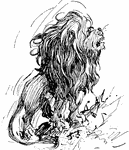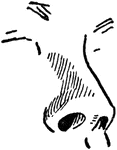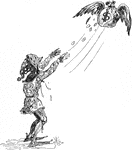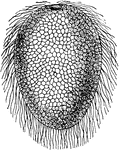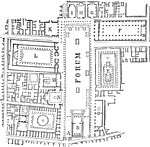
Forum of Pompeii
"Forum of Pompeii. A, principal entrance; B, a Corinthian temple; C, the public prison (carcer publicus);…

Fourpenny Piece of Queen Victoria
The obverse and reverse sides of the fourpenny piece, or groat, an English silver coin worth fourpence.

Obverse Side of Silver Franc of Henry III
"A French silver coin and money of account which since 1795 has formed the unit of French monetary system."…
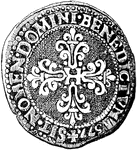
Reverse Side of Silver Franc of Henry III
"A French silver coin and money of account which since 1795 has formed the unit of French monetary system."…
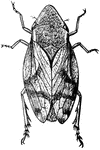
Dorsal View of Froghopper
Aphrophora quadrangularis is a species of Froghopper, an insect in the order Hemiptera.
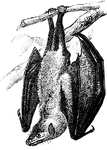
Fruit Bat Hanging from Tree
The image shows a fruit bat, a bat from the Pteropodidae family of megabats.
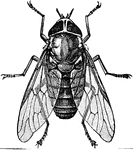
Dorsal View of Horsefly
Tabanus americanus is a species of biting horsefly in the Tabanidae family of horseflies. It was also…
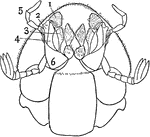
Ventral View of Dung Beetle
"Under Surface of Head of Tumble-bug (Copris carolina), about four times natural size. 1, galea; 2,…
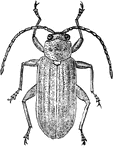
Dorsal View of Leaf Beetle
Galeruca notata is a beetle species in the Chrysomelidae family of leaf beetles.
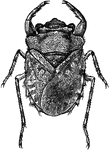
Dorsal View of Toad Bug
Galgulus oculatus is a true bug species in the Gelastocoridae family of toad bugs.

Prisoner Drilling Hole
An illustration of a prisoner drilling a hole in the wall of his prison cell.

Skull of Common Fowl
"Typical Skull of Common Fowl (Galliformes). A, side view: sa, surangular bone of mandible; ar, articular…
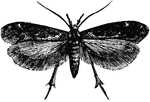
Dorsal View of Gall Moth
Gelechia gallae-solidaginis is a species of gall moth, an insect in the Gelechiidae family of Gelechiid…

Cathedral of Cologne
The Cathedral of Cologne is renowned as a monument of Christianity and of Gothic architecture. It is…
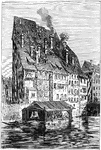
Ancient Houses in Strasburg
Strasburg, originally known as Strateburguen in the sixth century, on the first partition of the Frankish…

Black Forest Village
View of a village in the Schwartzwald, or Black Forest. The Black Forest stands in the elbow formed…

Abbey of Allerheiligen
Abbey of Allerheiligen, or All Saints, this abbey is beautifully situated on the banks of the Lierbach,…
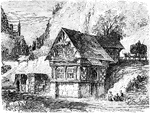
Peasant's House in the Black Forest
View of a peasant's house in the Black Forest. The scene includes an ox cart loaded with hay, children…
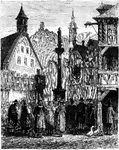
Simonswald
Archaeological artifacts show that Simonswald was home to farmers as early as 6000 to 3000 BC. Roman…
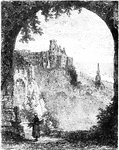
Heidelberg Castle Viewed from Terrace
View of the castle framed by an arch. A landmark of Heidelberg, the castle ruins are among the most…

Interior of Heidelberg Castle
Interior view of Heidelberg Castle with elaborately carved doorway and part of a courtyard.

Ratisbon
Regensburg, also Ratisbon, Ratisbona, is a city in Bavaria, Germany, located at the confluence of the…

Statue of Bavaria
The Statue of Bavaria is a bronze-cast statue of a female figure representing Bavaria's "secular patron…

Glyptothek
The Glyptothek is a museum in Munich, Germany, which was commissioned by the Bavarian King Ludwig I…

Pinacothek
The Alte Pinakothek (Old Pinakothek) is an art museum situated in the Kunstareal in Munich, Germany.…
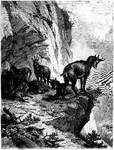
Chamois
The chamois (Rupicapra rupicapra) is a goat-like animal, living at moderately high altitudes and are…

Falkenstein Castle
Falkenstein Castle or Castrum Pfronten is a High Middle Ages castle ruin in the Bavarian Alps, near…
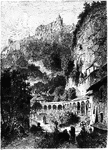
Peter's Churchyard in Salzburg
The collegiate church of St. Peter was built in the Romanesque style in the twelfth century. The burial…
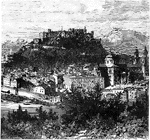
View of Salzburg
Salzburg was a city state in the Roman empire until 1805, when it was conquered by the Austrian army.…

Wilhelma
The Wilhelma was originally a royal palace, mimicking Moorish architecture. After the second world war,…

Castle of Hohenzollern
The ancestral home of Conrad of Hohenzollern and the third castle constructed on the site. The castle…

Lintz on the Dabube
A picturesque view of Lintz (Linz) on the Danube with a small number of buildings on the river banks.…

View of Lintz
A picturesque view of the Lintz (Linz) city center. Lintz was founded by the Romans, who called it "Lentia."…
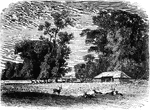
The Prater
The Wiener Prater is a large public park in Vienna's 2nd district Leopoldstadt. Prater is derived from…

The Gloriette at Schönbrunn
The Gloriette at Schönbrunn, a elegant pavilion is a miniature reproduction of the Palace of Schönbrunn.…

The Belvedere Garden
The Belvedere is a baroque palace complex built by Prince Eugene of Savoy Vienna, Austria. This view…
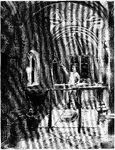
Striking the Christmas Chimes at St. Stephen's Cathedral, Vienna
View of man striking the Christmas chimes at the Cathedral of St. Stephen, also called Stephansdom,…

Dorsal View of Gastrochaena
"Dorsal View of Gastrochaena. The ventral view shows the dried mantle with pedal perforation." -Whitney,…

Ventral View of Gastrochaena
"Ventral View of Gastrochaena. The ventral view shows the dried mantle with pedal perforation." -Whitney,…

Lateral View of Gastrochaena
"Lateral View of Gastrochaena. The ventral view shows the dried mantle with pedal perforation." -Whitney,…

Obverse and Reverse Sides of a Gazzetta
"Gazzetta of the Ionian islands, 1801. A small copper coin, worth about 3 farthings, made in Venice…
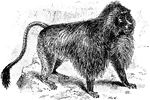
Gelada Baboon
The Gelada (Theropithecus gelada) is a baboon relative in the Cercopithecidae family of Old World monkeys.

Cormorant
The Cormorant "P. carbo, but has a tuft of long narrow recurved plumes on each side f the crown in the…

Secretary Bird
"Standing some four feet high on very long legs, this bird (Secretary Bird) gives the impression of…
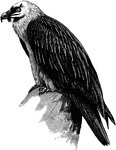
L&emumlmmergeier
"Gypaëtus barbatus, the magnificent L&emumlmmergeier, is greyish-black with white streaks, and has…
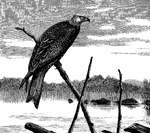
Red Kite Resting on a Branch by a Body of Water
"Milvus milvus, the Red Kite or Forked Tail Glead of the Old World, ranging from the Atlantic Islands-except,…
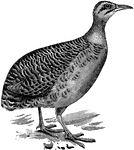
Red-winged Tinamou
"Rhynchotus rufescens,... is grey-brown, with blacker crown, rufous cheeks, neck, and breast, and chestnut…

Pheasant
"Phasianus colchicus, Pheasant, ...has a white collar and slaty lower back with dark green barring;…

Trumpeter
"Psophia crepitans, the Agami, ranging from British Guiana to Amazonia, is a black bird with velvety…
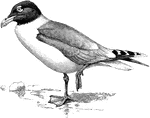
Great Black-Headed Gull
"Larus ichthyaetus, the Great Black-headed Gull, ranging from the Black Sea and the Levant to Tibet,…
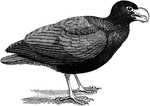
Tooth-Billed Pigeon
Didunculus strigirostris, the Manu-mea or Red Bird of the islands of Upolu, Salvai, and Tutuila in Samoan…
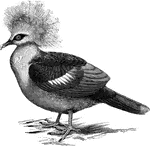
Crowned Pigeon
"Goura coronata, the Crowned Pigeon, discovered by Dampier in 1699, is bluish-slate -coloured, with…


